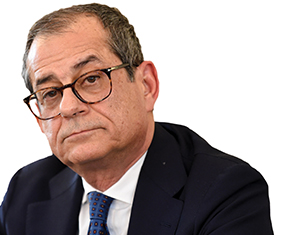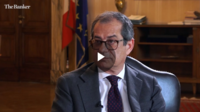Holding public office is by definition challenging, but Italy’s finance minister, Giovanni Tria, carries a particularly heavy load. He has to find ways to fund the expensive plans of his government, such as the so-called citizenship income and the reduction of the pensionable age, which, for a country saddled with a heavy public debt, expensive debt servicing and experiencing barely any growth, is an onerous task.
To make matters worse, the confrontational attitude of the coalition government’s leaders, Luigi Di Maio of the populist Five Star Movement and the far-right Northern League’s Matteo Salvini, towards Europe and, often, towards each other, have rattled the markets, spiking bond yields and making government borrowing more expensive.
Speaking to The Banker in early May, Mr Tria explains how “the [confrontational tone] is higher in national politics [now, rather than with Europe]”, and that “after the [May European] elections I expect a further decline in interest rates”. But barely two weeks after his comments, borrowing costs rose again as Mr Salvini, who is also deputy prime minister and interior minister, said Italy could well break European rules on its budget deficit and government debt. Mr Di Maio, also deputy prime minister and economic development minister, described Mr Salvini's comments as “irresponsible.” Yields on the 10-year benchmark rose by 3.2 basis points to 2.77% in the aftermath of these comments and some fear a coalition break-up after the European elections.
Fighting Europe
The current government wrestled with Europe over rules based around its economy soon after its creation in April 2018, reaching a peak in September. Eurozone members are bound to the limits of a 3% budget deficit and a 130% to 140% debt-to-gross domestic product (GDP) ratio. Italy's public debt – the highest in Europe after Greece – means that it is expected to be extra cautious with its spending. During 2018’s spat with EU leaders, Mr Tria offered markets the hope of practicality and common sense. In the end, agreement was found on a 2.04% deficit, which economic expectations of a 1% GDP growth would have helped support. But deteriorating economic conditions have now pushed the coefficient to 2.4% for 2019, according to the government’s latest figures. The European Commission (EC) fears that this could reach 3.5% by 2020. On top of this, the debt-to-GDP ratio is expected to rise to 132.6%.
Still, Mr Tria believes that Brussels’ requests are “excessive in the sense that it’s a rule... I don’t think that rules should be applied flexibly, [but] rules themselves need to be flexible. You cannot go forward just with [rigid] rules.” He insists that Italy’s high debt levels should not worry those outside the country. “Italy’s public debt is not Europe’s problem, it’s an Italian problem,” he says. “Italy’s debt is sustainable, it doesn’t endanger anyone, but it damages Italy.”
But the Italian economy is ailing. It exited recession at the end of 2018 but forecasts for 2019 point downwards. Mr Tria’s updated view is for 0.2% GDP growth for 2019, which he expects to pick up as conditions improve. But others are less optimistic about the future. The EC and Organisation for Economic Co-operation and Development (OECD) have voiced concerns over Italy's economy, with the OECD expecting a contraction, as opposed to growth, of 0.2% for 2019 and a modest recovery in 2020. But longer term growth prospects may be shakier still. Research firm Capital Economics believes that Italy may be stuck in a no-growth zone for the next decade, which some fear could lead to two possible catastrophic scenarios: a default on sovereign debt, or a eurozone exit that will free the country from EU rules and allow for a currency devaluation.
Mr Tria finds these curious conclusions. “We’re facing an economic slowdown that is not just about Italy. It’s a slowdown [related to] Europe,” he insists, and notes how, depending upon the perspective it is viewed from, Italy is not in such bad shape. The country has a positive balance of payments and solid exports. There is a well-known productivity gap but, at an individual level, there are companies that outperform international peers. A closer examination of the overall composition of debt, both in public and private hands, also gives hope, as it is lower than other countries in Europe, according to Mr Tria
Video interview with Italy's finance minister Giovanni Tria
The search for growth
Yet it remains unclear where Italy's growth will come from, and what will generate revenues for the government. There is uncertainty over planned VAT hikes, which if abandoned might push Italy beyond the 3% deficit ratio, as the Bank of Italy warned in April.
Mr Tria says that any changes to planned tax hikes or other measures would have to be agreed under a new budget law, and does not elaborate on what might replace the lost revenue beyond saying that lower revenues would mean less spending. Furthermore, there are no obvious plans for the €17bn-worth of privatisations that were meant to take place in 2019.
No quick or painless solutions are in sight for Italy’s heavy government debt ratio. The cost of servicing such debt alone has tilted Italy into fiscal deficit since 1992, when the country admirably started running an almost continuous fiscal surplus.
Mr Tria says that this primary surplus reveals that Italy is indeed a safer bet than it might appear. Furthermore, while interest rates remain low, buying Italian debt “is a good deal for investors – it certainly is not a good deal for Italy”, says Mr Tria; he insists that Italy’s debt is “safe” because it is backed by a large economy – even if it the economy is not growing – and provides high returns. “[The current low interest-rate-environment] is positive for us because makes it easier to finance our debt, even if we pay more than other countries,” says Mr Tria. He adds: “The average rate on overall stock of debt continues to decline. It is now about 2.8%, and it continues to decline even if we have such a high spread on 10-year [bonds].” On May 14, after Mr Salvini’s controversial comments, the spread over German 10-year bonds rose to 282 basis points, a three-month high.
China plan
It is not just bond investors that Italy is wooing. Earlier in 2019, Italy became the first G7 country to officially join the Belt and Road Initiative (BRI), China’s $1000bn programme to improve connections along a new Silk Road that stretches across land and sea routes. The Italian ports of Trieste and Genoa had been initially mentioned, as well as deals with banks and industrial companies.
The announcement did not come without controversy, given that the EU is becoming increasingly involved in vetting foreign investments in the bloc. Many are voicing concerns about the lack of transparency of Beijing’s financing deals. Most recently, there have been accusations that BRI investments in Pakistan are burdening the country with excessive debt. As Pakistan had to turn to the International Monetary Fund for help with, among other things, its external debt, some observers worry that much of the fund’s $6bn rescue package, recently approved in principle, would be used to repay China.
But Italy is not Pakistan, insists Mr Tria: it is a large, developed economy. Other European countries deal with China, he notes, and in a much more substantial way than Italy does. “I’m rather surprised by the reaction to Italy’s decision to sign this memorandum of understanding [with China] because it’s a very general [agreement]. A co-operation [agreement] is one thing, but another is how and in what [areas this] will materialise.
“The other European countries that were surprised [by our decision] have participated in the BRI more than Italy has. The BRI land route gets to Duisburg [in Germany]; [China’s] investments in ports have not been in Italy so far, they have been in Greece and [the Netherlands]. There is competition between European countries to take part in the BRI programme. This strange reaction has been caused more by competition between European countries than by anything else.”
Whether regarding public finances or its choice of investment partners, tensions between Italy and Europe may not abate any time soon. Confrontation with Brussels and within the government is unlikely to do much to reassure markets, already worried about inaction on revenue boosting plans. As the economy stagnates, Italy’s finance minister will continue to have a singularly challenging job.














